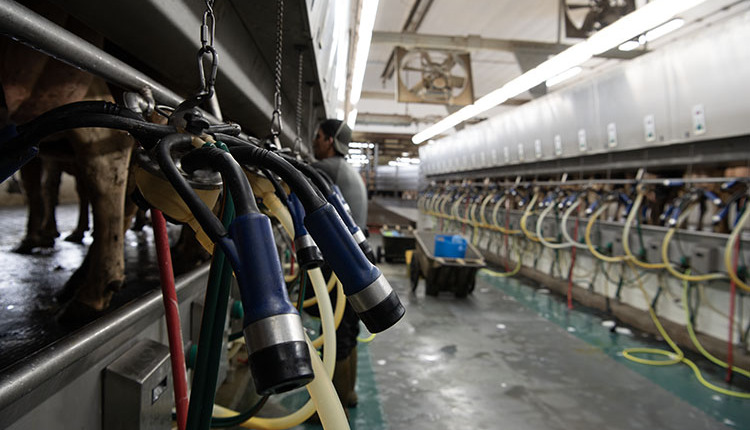Steve Ingham, food science professor at University of Wisconsin-Madison, was the lead researcher and is now a food safety administrator with the state.
The findings of this report upset some smaller producers because the "smaller is better" concept did not hold true. The personal attention some of the smaller operators believe they provide and larger herds do not; were not seen in the milk quality results. Unfortunately, smaller producers often chose to use the terms "factory farms" to describe their fellow dairy producers – pitching one demographic of the industry against the other. The national average for herd size continues to rise due, in part, to purchasing input costs in bulk results in lower input costs per unit.
Larger herds have more employees, so they each have specialized responsibilities, such as milking, calf care, or reproduction. We've all heard the phrase "jack of all trades and master of none." Larger operations have the ability to hire individuals to handle specific tasks, and, when you can focus on doing one thing well, it becomes the most important task. Trying to be a "jack of all trades" is a valuable asset, but where is the focus? Just getting all the tasks completed might be the focus. Because of their size, large operators have the ability to hire trained staff, purchase new equipment, and invest in technology – all which can impact milk quality (as seen in somatic cell counts).
However, just having a large herd does not guarantee low SCC milk; nor does having a smaller herd mean higher counts either. But, as producers, we must understand what the research is telling us – on average, larger herds have milk that is lower in somatic cells which can affect milk shelf-life and the ability to convert milk into dairy products.
Look over the DHI (Dairy Herd Information) data below as provided by USDA:
2010 Avg. herd size: 145 cows Avg. SCC: 285,000
• The top 5 states for the lowest somatic cell average 622 cows (177 to 1647 cows) and have somatic cell counts of 170,000 to 189,000.

• The 7 leading states for cow numbers (596 to 1,970 cows) average 214,000 SCC and average 22,037 pounds of milk per cow. Larger herds (on average) produce more milk per cow. The national SCC average is quite a bit higher at 285,000 SCC and lower milk production (21,149) per cow.

• The highest 5 states for SCC average 395,000 SCC and average 105 cows per herd (all under 145 cows), while the national average is 285,000 SCC. The highest SCC results all came from herds smaller than the national average.
Based on this USDA data, the national statistics support the findings of this Wisconsin report.
The take-aways:
• Dairy producers need to stop throwing stones at each other. The school-yard lesson applies here: You cannot make yourself look better just by tearing down others. We see it too often in political campaigns, and no one looks good in the end.
• Your herd SCC is not predestined by your herd size and location. Your management dictates your own herd's results. There may be challenges with climate and facilities, but you ultimately have to manage those obstacles.
If all producers, regardless of size and location, continue to produce high-quality milk and respect the diversity of our dairy landscape, the entire dairy industry and all consumers will benefit.
Link to the study's abstract can be found here. The entire report can be found in the August 2011 Journal of Dairy Science, Volume 94, Issue 8 , Pages 4237-4241.
The findings of this report upset some smaller producers because the "smaller is better" concept did not hold true. The personal attention some of the smaller operators believe they provide and larger herds do not; were not seen in the milk quality results. Unfortunately, smaller producers often chose to use the terms "factory farms" to describe their fellow dairy producers – pitching one demographic of the industry against the other. The national average for herd size continues to rise due, in part, to purchasing input costs in bulk results in lower input costs per unit.
Larger herds have more employees, so they each have specialized responsibilities, such as milking, calf care, or reproduction. We've all heard the phrase "jack of all trades and master of none." Larger operations have the ability to hire individuals to handle specific tasks, and, when you can focus on doing one thing well, it becomes the most important task. Trying to be a "jack of all trades" is a valuable asset, but where is the focus? Just getting all the tasks completed might be the focus. Because of their size, large operators have the ability to hire trained staff, purchase new equipment, and invest in technology – all which can impact milk quality (as seen in somatic cell counts).
However, just having a large herd does not guarantee low SCC milk; nor does having a smaller herd mean higher counts either. But, as producers, we must understand what the research is telling us – on average, larger herds have milk that is lower in somatic cells which can affect milk shelf-life and the ability to convert milk into dairy products.
Look over the DHI (Dairy Herd Information) data below as provided by USDA:
2010 Avg. herd size: 145 cows Avg. SCC: 285,000
• The top 5 states for the lowest somatic cell average 622 cows (177 to 1647 cows) and have somatic cell counts of 170,000 to 189,000.

• The 7 leading states for cow numbers (596 to 1,970 cows) average 214,000 SCC and average 22,037 pounds of milk per cow. Larger herds (on average) produce more milk per cow. The national SCC average is quite a bit higher at 285,000 SCC and lower milk production (21,149) per cow.

• The highest 5 states for SCC average 395,000 SCC and average 105 cows per herd (all under 145 cows), while the national average is 285,000 SCC. The highest SCC results all came from herds smaller than the national average.
Based on this USDA data, the national statistics support the findings of this Wisconsin report.
The take-aways:
• Dairy producers need to stop throwing stones at each other. The school-yard lesson applies here: You cannot make yourself look better just by tearing down others. We see it too often in political campaigns, and no one looks good in the end.
• Your herd SCC is not predestined by your herd size and location. Your management dictates your own herd's results. There may be challenges with climate and facilities, but you ultimately have to manage those obstacles.
If all producers, regardless of size and location, continue to produce high-quality milk and respect the diversity of our dairy landscape, the entire dairy industry and all consumers will benefit.
Link to the study's abstract can be found here. The entire report can be found in the August 2011 Journal of Dairy Science, Volume 94, Issue 8 , Pages 4237-4241.











